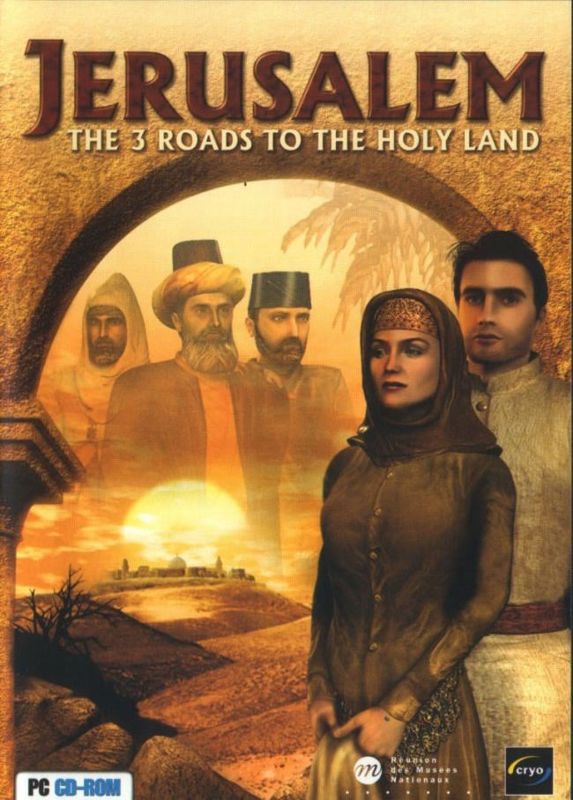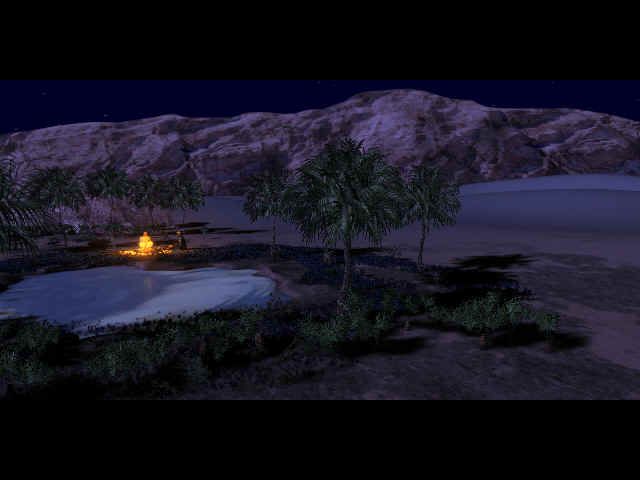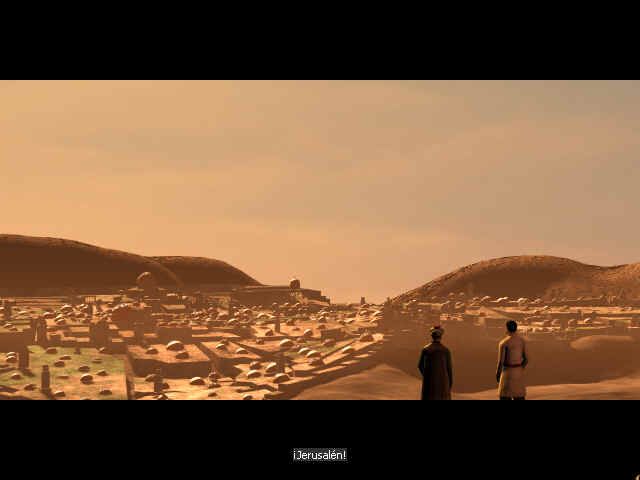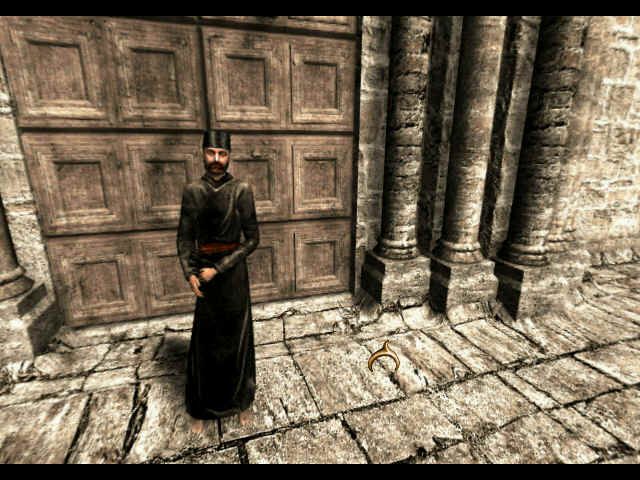Retro Replay Review
Gameplay
Jerusalem: The Three Roads to the Holy Land builds upon the point-and-click adventure tradition established in Pompeii: The Legend of Vesuvius. You step into the shoes of 20th century cartographer Adrian Blake and guide him through richly detailed environments, switching between first-person exploration and occasional third-person action sequences. The controls are intuitive, with context-sensitive cursors that let you examine, take or use objects. This dual perspective approach keeps the pacing fresh by alternating contemplative puzzle solving with moments of cinematic tension.
(HEY YOU!! We hope you enjoy! We try not to run ads. So basically, this is a very expensive hobby running this site. Please consider joining us for updates, forums, and more. Network w/ us to make some cash or friends while retro gaming, and you can win some free retro games for posting. Okay, carry on 👍)
Puzzles in Jerusalem lean heavily on dialogue and environmental clues. Many challenges require collecting artifacts, deciphering religious symbols or trading items with non-player characters. Conversations with locals from Judaism, Islam and Christianity are not mere exposition; they offer hints to unlock hidden compartments or decode ancient manuscripts. Inventory management is straightforward but crucial—some items have multiple uses depending on which religion’s tradition you’re exploring, adding layers of depth to each solution.
The game’s progression is non-linear, allowing you to tackle objectives in several orders. You might chase leads on Abraham’s holy dagger while simultaneously gathering information about Governor’s daughter’s whereabouts. This freedom encourages backtracking and re-examination of earlier locations once you acquire new religious texts or keys. Although a built-in journal tracks your clues, avid puzzle fans will appreciate how the game rewards close reading and cultural awareness.
Despite the occasional obscure solution—where a minor detail in a lengthy conversation holds the key—the overall gameplay loop remains highly engaging. NPCs are memorable and react to your successes or missteps, and the sense of discovery as you piece together three interwoven religious traditions makes each breakthrough gratifying. The balance between narrative moments and cerebral challenges will appeal to adventure game purists and newcomers alike.
Graphics
Visually, Jerusalem excels in recreating 16th century Jerusalem with remarkable authenticity. The developers employed hand-painted backdrops and high-resolution textures to depict bustling souks, ornate mosques, synagogues and the iconic Church of the Holy Sepulchre. Light and shadow are handled dynamically, casting a warm glow through stained glass windows or flickering torchlight in dim alleyways. This attention to detail immerses you deeply in the period setting.
Character models and animations are serviceable, though not without their quirks. While face rigs occasionally falter in close-ups, the expressive body language and period costumes convey cultural distinctions vividly. Watching Muslim, Jewish and Christian worshippers perform their respective rituals feels authentic. Minor clipping issues or stiff movements rarely detract from the overall beauty; the environments themselves are the true stars of the presentation.
Cutscenes blend seamlessly with gameplay thanks to consistent art direction. When Adrian confronts a suspicious trader or unearths an ancient relic, the camera angles shift to highlight key details without breaking immersion. Subtle effects such as drifting dust motes in sunbeams or ripples on marble floors underscore the sense of history embedded in every stone. The color palette—from the vibrant dyes of marketplace stalls to the sandy hues of city walls—feels both coherent and evocative.
Overall, the graphics strike a fine balance between realism and painterly stylization. They serve the game’s educational and narrative goals by emphasizing architectural and cultural landmarks. Whether you’re roaming the Temple Mount or slipping into a hidden crypt, the visual design consistently enhances the feeling of exploring a living, breathing holy city.
Story
The narrative thrust of Jerusalem: The Three Roads to the Holy Land centers on Adrian Blake’s perilous quest to find his beloved Sophia, who has gone missing under mysterious circumstances. Your search leads to the governor’s palace, where you learn that the legendary holy dagger of Abraham has been stolen and the governor’s daughter kidnapped. This dual crisis sets a high-stakes backdrop that keeps you motivated from the opening credits to the climactic finale.
What elevates the story is its integration of three major world religions. As Adrian navigates the winding paths of faith, he uncovers parallels and contrasts between Judaism, Islam and Christianity. Dialogues with rabbis, imams and priests are not only informative but emotionally resonant, illustrating shared values such as compassion and justice. The game respects each tradition, avoiding stereotypes and inviting players to appreciate cultural nuance.
Character development is anchored by Adrian’s earnest determination and occasional self-doubt. His rapport with Sophia is revealed through flashbacks and journal entries, reminding you of what’s at stake. The governor’s daughter, though initially a mystery, becomes more than a damsel in distress as you learn her own backstory and personal convictions. Even secondary characters—street urchins, scholars and merchants—exhibit unique personalities, enriching the tapestry of subplots.
The pacing of the storyline is measured, alternating suspenseful revelations with quieter moments of reflection. Early on, you might decrypt an ancient inscription; later, you’ll confront moral dilemmas about cultural appropriation and religious tolerance. By the time you reach the denouement, the intertwining arcs of romance, intrigue and theology converge in a finale that feels both dramatic and thoughtfully constructed. The result is a story that educates as it entertains.
Overall Experience
Jerusalem: The Three Roads to the Holy Land delivers a compelling blend of education and entertainment. As you guide Adrian Blake through meticulously designed locales, you’ll encounter puzzles that challenge both your intellect and cultural sensitivity. The variety of gameplay—first-person exploration, third-person action scenes and deep, branching dialogues—ensures that the adventure never becomes monotonous.
What truly sets the game apart is its respectful, nuanced portrayal of Judaism, Islam and Christianity. Rather than using religion as mere window dressing, the developers weave doctrinal and historical insights into the core of each puzzle and conversation. Players emerge with a deeper appreciation for the shared heritage of these faiths, making the experience as enriching as it is thrilling.
While a few technical hiccups—minor animation glitches or occasional backtracking—might frustrate completionists, the game’s overall polish and care in research far outweigh these shortcomings. The evocative graphics, memorable characters and layered narrative make for an adventure that lingers long after you’ve found Sophia and recovered the holy dagger.
For fans of classic point-and-click adventures, history buffs and anyone intrigued by the crossroads of faith and culture, Jerusalem: The Three Roads to the Holy Land offers an unforgettable journey. Its combination of brain-teasing puzzles, authentic settings and heartfelt storytelling makes it a standout title that any adventure gamer should consider adding to their library.
 Retro Replay Retro Replay gaming reviews, news, emulation, geek stuff and more!
Retro Replay Retro Replay gaming reviews, news, emulation, geek stuff and more!









Reviews
There are no reviews yet.